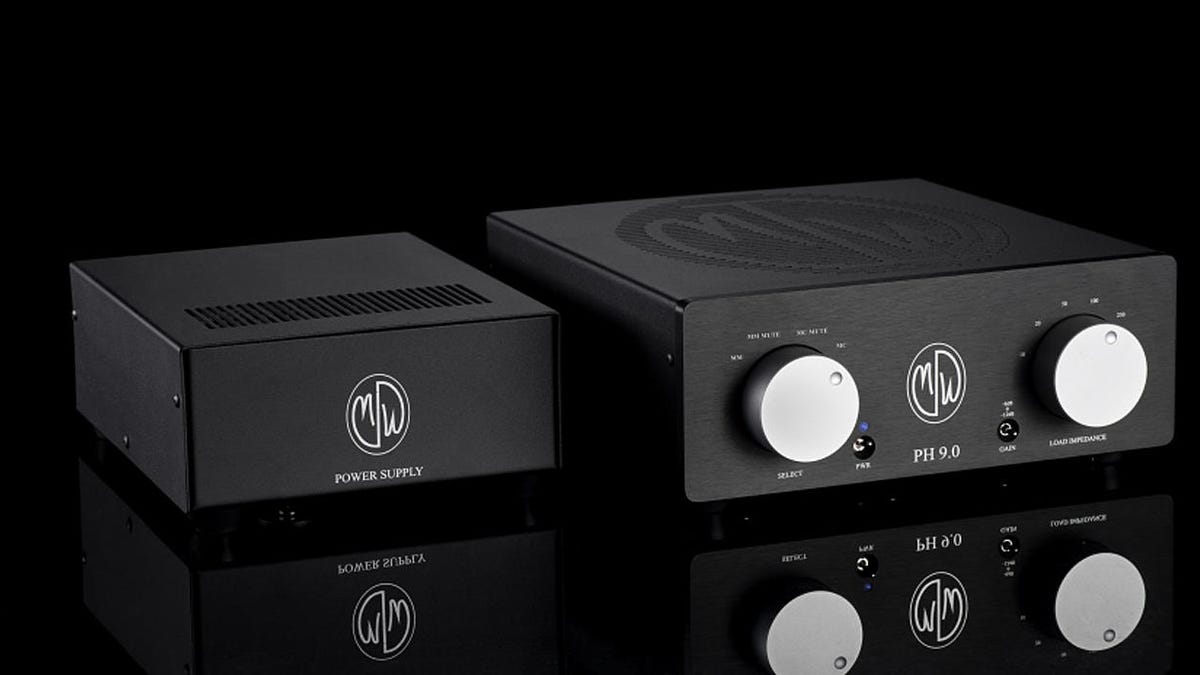This preamp takes you deeper into the sound of LPs
There’s magic in an LP’s grooves, and the ModWright PH 9.0 phono preamp lets you hear more of it.

The ModWright Instruments PH 9.0 preamp on the right, power supply on the left
I've admired ModWright Instruments components from afar for years at audio shows. The company's design aesthetic has been clean and straightforward, the sound honest and true.
I haven't covered much in the way of vacuum tube components this year, but when I heard the new ModWright PH 9.0 tube phono preamp I knew it deserved a more extended listen at home. And now that it's here, I'm so glad I made the request. LPs sound more "analog" played over a great tube preamplifier, they just do.
ModWright Instruments PH 9.0 rear panel
The PH 9.0 is designed and handcrafted in the US, and uses parts from a mix of US and Asian suppliers. Every PH 9.0 is tested and listened to by the company's owner, Dan Wright. The US price is $2,900 and it's AU$4,500 in Australia. ModWright doesn't currently have distribution in the UK so they ship directly to UK customers; the PH 9.0's US price converts to £2,300.
The PH 9.0 is a two-box design, the phono preamp section has front panel controls and connectivity jacks on the rear panel, and there's a separate power supply. The preamp has a selector control for moving-magnet and moving-coil cartridges, and the front panel's "on the fly" impedance control settings of 10, 20, 50, 100, 250, and 470 ohms makes it super-easy to hear how impedance "loading" changes the sound of moving-coil cartridges. Just turn the knob and listen to discover which setting sounds best. The PH 9.0 is a zero feedback design.
The preamp measures a tidy 10 by 10 by 4 inches (254 by 254 by 102mm); the separate power supply is 7 by 9 by 3 inches (178 by 229 by 76mm). A Mono/Stereo toggle switch is located on the preamp's rear panel. The review sample had RCA inputs and outputs, but a fully balanced version of the preamp with transformer-coupled XLR outputs is available as an extra cost option.
The preamp design utilizes four tubes, two 6C45s and two 6922s. The stock tubes sounded fine, but I couldn't resist experimenting with a few other tubes to see how they changed the sound. Amperex 6922 tubes warmed up the sound, adding maybe too much tube flavor for my taste, so I popped in a pair of old Russian Sovtek 6922 tubes, which had the best balance of soul and transparency. You can find 6922s on eBay for anywhere from $10 to more than $100 per tube! That's one of the big advantages of tube electronics -- you can get a new sound just by swapping out the tubes! A set of tubes should provide 3,000 to 4,000 hours of use before they need to be replaced.
A look inside the ModWright Instruments PH 9.0
For this review I used my SME Model 15 turntable fitted with a Ortofon Cadenza Blue moving-coil cartridge.
Listening to the PH 9.0
It's been a long time since I heard a tube phono preamp in my home system, and right away it was clear the tubes enhanced the analog "flavor" of the sound of my LPs; there's no better way to put it. The highest compliment I can pay the PH 9.0 is that it widened the gap between the sound of my LPs and CDs and audio files.
The preamp revealed more soundstage depth, while solid-state preamps sounded dimensionally flatter. Whether the depth was a "distortion" created by the tubes I can't say for sure, but I liked the way it sounded. I almost felt like I could get up from my listening chair and walk into the soundstage.
It's interesting that even after all these years, the best of analog and digital audio are still so far apart. That's not to say digital is inferior, just that they're not getting more like each other. They sound very different, though which one is better is up to you.
With the Cabaret film soundtrack, Liza Minnelli's powerhouse vocals pinned me to my listening chair. This 1972 recording never sounded better. It's shocking how much sound was hiding in the grooves of a nearly half-century-old LP I bought for $1. There was simply more life to the sound; I felt like I was hearing more of the music.
With the PH 9.0, musical dynamics flowed effortlessly, more like they do in real life. In that sense, the PH 9.0 sounded more powerful than my Parasound Halo JC-3+ solid state preamp.
Relative to the JC 3+, the PH 9.0 sounds spatially bigger and more expansive. The soundstage had more depth; instruments sounded more like themselves. The JC 3+'s bass definition and shading outclassed the PH 9.0, but not by all that much. The JC 3+ sound was also crisper, more exacting, the PH 9.0 was freer, more limber. I liked both, there's no clear winner in that contest.
I've played legendary saxophonist John Coltrane's Ballads LP for decades, but never noticed the studio ambiance before. It was always in the recording, but now with the PH 9.0, I feel like I was in the studio with the band.
The Rolling Stones' Still Life 1981 concert album isn't a great recording. It can sound "canned," and compressed, but it's less so with the PH 9.0. The Stones original bass player, Bill Wyman was still in the band, and his nimble touch on the strings propelled the music. The band hasn't been the same without Wyman, that's for sure.
So to all of you vinyl loving audiophiles seeking a bit of tube magic the ModWright Instruments PH 9.0 comes highly recommended, it's a delight.

